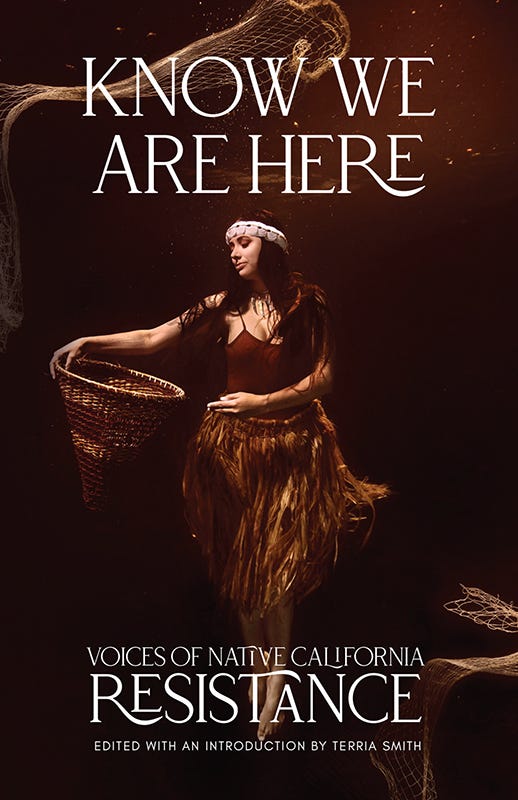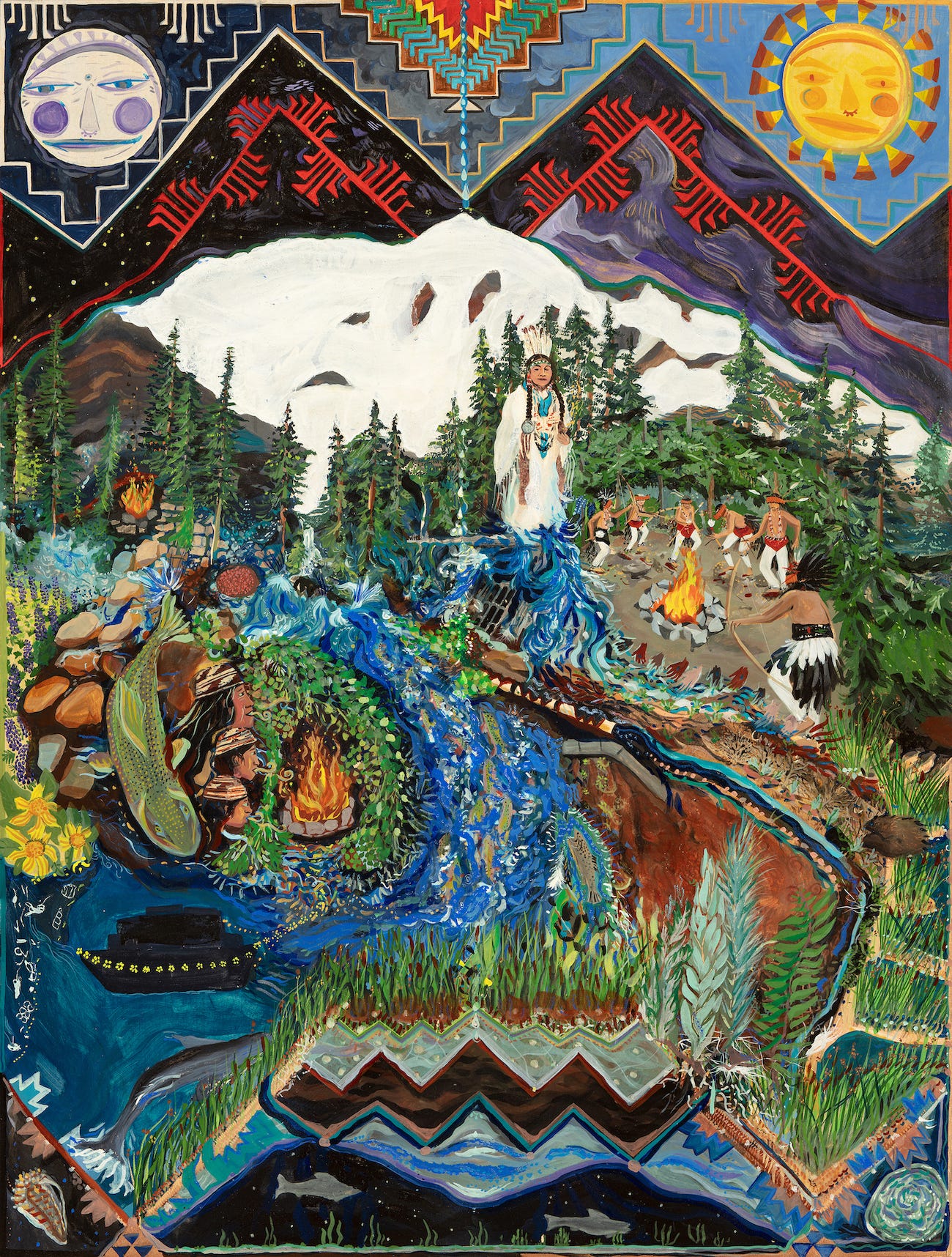Reindigenize, Everywhere
Centering native sovereignty in all that we do
Jasmine was about to leave the car, looked at me and noted “So much of your practice is about indigeneity, isn’t it?” As usual, her intuition was spot-on. Being someone who is not native to the lands that my first, fourth, or more generations-back settled on, why is indigenousness at the center of my visual, ecological, and pedagogical practice?
Our collective survival hinges on native lifeways. Not in a purist or extractive kind of way, but in a respectfully learning what we can from Indigenous culture-bearers while becoming accomplices way. Humbling to become more respectful and supportive to the nature we are dependent on. Reaching to the lineages of indigeneity that we come from, and so much more beyond my limited perspective.
Uplifting the sovereignty of Turtle Island is our responsibility as Earthworkers. Indigenous people hold living and blood memory on caring for these lands in ways that Western minds can’t fathom. Returning all Indigenous territory to Indigenous hands is the path to recovery.
Reindigenization looks different everywhere. It expresses uniquely according to local customs, relationships, colonial impacts, underground networks, survivors’ capacity, current settlers with configurations of power, health of habitat, worldview, hybridity, etc.
Reindigenization isn’t a glorification or return to the past, but an emergent path led by the people whose ancestors grew from, within, and as local place since time immemorial. It must come from here.
I recently had the pleasure of reading Know We Are Here: Voices of Native California Resistance. (Thank you champoy for gifting me this book!) This book should be required reading for Californians. Each Chapter holds unique perspectives from people Indigenous to the diverse lands here. The authors come from a range of tribes, ages, perspectives, and styles. Stories of inherited belonging, colonial terror, and present-day complexities expose layers of coastal city fantasy that California occupies in popular imagination.
Ohlone, Miwok, Kumeyaay, Cahuilla, Coast Miwok, Pomo, Chumash, Esselen, Tongva, Wintu, Hupa, Yurok, Karuk, Maidu, and Luiseño/Cupeño voices share testimonies that contest settler projections which flatten or invisibilize Native Californian identities.
The collection of essays is organized by histories of resistance; culture and language; place, nature and wellness; education; and solidarity. These are loveletters to homelands. There are impacts of genocide and aftermath marking mountains and valleys. People are places and California has the most colonized waterways in the world: dammed, canalized, ducted, and drained. There are scents of belonging, profound grief, and the grit to keep going with scraps of language left in a white anthropologist’s ill-equipped recordings.
Personal narratives illuminate what it’s like to walk in two worlds, skirt the margins of Westernized society, witness the impact of new age white sage overharvesting, and teach real Mission history of horror.
The perspective of coyote is brought in to wander present-day Tongva Lands (Los Angeles) by Cindi Alvitre. Multi-dimensions map a terrain not knowable by political boundaries or private homes.
How to grapple with the immensity of what’s been lost and what’s still at stake when so much is continually stolen? The never-ending journey toward recovering lifeways that sustain rather than drain our planet hinges on our ability to learn from indigeneity. How lucky to have native people and movements to learn from.
Salmon Home: Waterways Repair and Winnemem Wintu Cosmovision of Care, created in collaboration with Chief Caleen Sisk’s son, Michael “Pom” Preston, natural pigment and gouache on board, 2023, 36” x 48”
Dreams of the whales and our Beloved friend Mere led our family to the Run4Salmon. Envisioned by Chief Caleen Sisk of the Winnemem Wintu tribe, Run4Salmon is a prayerful journey to bring native salmon back to the watershed of Buyum Puyuk, or Mt. Shasta. For over 8 years now, folks have been running, biking, horseback riding, and paddling the route that the salmon should take from the headwaters of the McCloud River to the delta north of the Bay Area. Please consider learning more about this powerful movement and uplifting their work with a donation! They are on the run as I write this and can also use our prayers.
As we paddled down the river in 2023 I kept seeing a story map emerge to share connections and stories behind the run. From the Winnemem Wintu’s origin story to the call for all dams to come down, a painting asked me to channel. I asked Chief for permission to sketch it out. She had me work in collaboration with her son, Pom, who would make suggestions to improve and then approve the images. Nichelle Drake additionally provided advice.
Nur, as the Winnemem people call salmon, hasn’t been able to return to spawn upstream since the construction of the dams and flooding of the their village to make Lake Shasta in 1944. Nur wound up naturalized in New Zealand by way of a fishery. Chief’s vision is to bring back their ancestral salmon so that the people, rivers, and riparian ecologies can survive.
In an inspiring example of what recovery can look like, the Klamath River dams have come down and chinook (Pacific salmon) are returning this year for the first time since the hydroelectric systems were constructed between 1903 and 1962.
Chief finally has a seat at the table with California Fish and Wildlife in an advisory role while their partnership tests eggs in incubators and methods for transporting nur above and below the Shasta dams.
Sovereignty of the water means the dams come down, pesticides on agroindustrial sites are outlawed, riverbanks are regenerated with native flora, and tribes are returned their fishing and water rights. The sovereignty of water means she can rise and flow with seasonal surges, untamed by cement channels: depositing minerals, sheltering creatures, sinking groundwater instead of privatized profit.
The sovereignty of water comes from the sovereignty of tribes. The sovereignty of tribes comes with settlers stepping down and listening. It means reparations, land back, and collective remembrance of Earth ceremonies we learn from our ancestral lands, when possible, or practiced respectfully with permission of native teachers. When all else fails, we can go outside, give thanks, and ask habitat how we can support them.
Make indigenous lands borderless again. We all have a role in becoming future ancestors who helped to dismantle this empire and recenter the balance of relations. Cultivating place comes from the origin stories that got humans here in the first place. They are the ones who know how to find our way back home.
For folks interested in learning from one of my teachers: Olivia Chumacero is teaching Everything is Medicine, her class on indigenous world-views and practice, as part of the 2025 Ecocene Confluence in Tongva Lands. Sunday, June 22nd, from 11 am - 12 noon. Learn more and register here.



